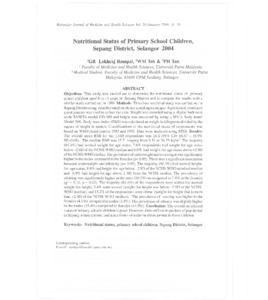Citation
Gyanchand Rampal, Lekhraj Rampal and Teh, W. M. and Tan, P. H.
(2006)
Nutritional status of primary school children, Sepang district, Selangor 2004.
Malaysian Journal of Medicine and Health Sciences, 2 (1).
pp. 11-23.
ISSN 1675-8544
Abstract
Objectives: This study was carried out to determine the nutritional status of primary school children aged 6 to 11 years in Sepang District and to compare the results with a similar study carried out in 1999. Methods: This cross-sectional study was carried out in Sepang District using stratified random cluster sampling technique. A pre-tested, structured questionnaire was used to collect the data. Weight was recorded using a digital bathroom scale TANITA model HD-309 and height was measured by using a SECA Body meter Model 208. Body mass index (BMI) was calculated as weight in kilograms divided by the square of height in meters. Classifications of the nutritional status of respondents was based on WHO classification 1983 and 1995. Data were analysed using SPSS. Results: The overall mean BMI for the 1,910 respondents was 16.8 (95% CI= 16.67 - 16.99; SE=0.08). The median BMI was 15 .7 ranging from 9.51 to 36.75 kg/m2. The majority (84.4%) had normal weight-for-age status, 7.6% respondents had weight-for-age status below -2 SD of the NCHS-WHO median and 8.0% had weight-for-age status above +2 SD of the NCHS-WHO median. The prevalence of underweight and overweight was significantly higher in the males compared to the females (p< 0.05). There was a significant association between underweight and ethnicity (p< 0.05). The majority (90.3%) had normal heightfor- age status, 8.8% had height-for-age below - 2 SD of the NCHS-WHO standard median and 0.9% had height-for-age above 2 SD from the NCHS median. The prevalence of stunting was significantly higher in the male (10.3%) as compared to 7.4% in the females (X2 = 5.11, P = 0.02). The majority (81.4%) of the respondents were within the normal weight-for-height, 3.4% were wasted (weight-for-height was below - 2 SD of the NCHSWHO median) and 15.2% of the respondents were obese (weight-for-height that is more than +2 SD of the NCHS-WHO median). The prevalence of wasting was higher in the females (4.1 %) compared to males (2.8%). The prevalence of obesity was slightly higher in the males (15.4%) compared to females (14.9%). Conclusion: The overall nutritional status of primary schools children is good. However, there still exists pockets of population in Sepang where chronic and acute forms of undernutrition persist in these children.
Download File
![[img]](http://psasir.upm.edu.my/41163/1.hassmallThumbnailVersion/Nutritional%20status%20of%20primary%20school%20children%2C%20Sepang%20District%2C%20Selangor%202004.pdf)  Preview |
|
PDF
Nutritional status of primary school children, Sepang District, Selangor 2004.pdf
Download (4MB)
| Preview
|
|
Additional Metadata
Actions (login required)
 |
View Item |

